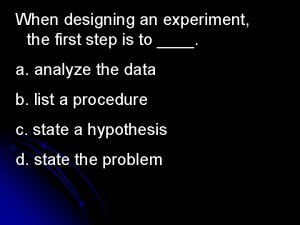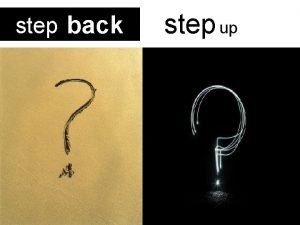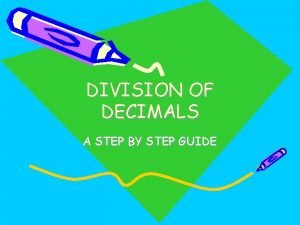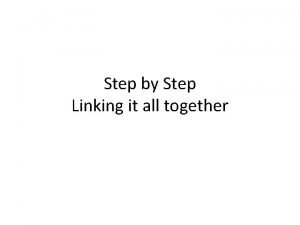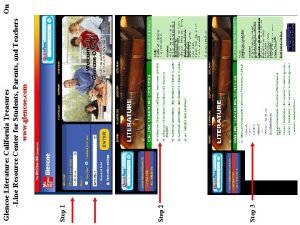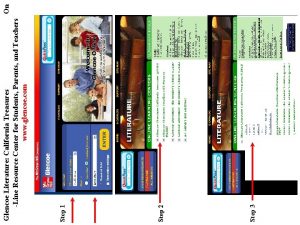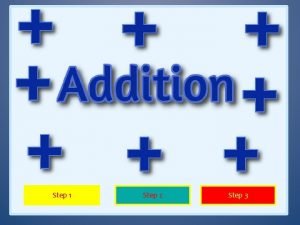Step 4 Designing the Activity Our Roadmap Designing


































- Slides: 34

Step 4: Designing the Activity

Our Roadmap Designing the Activity

Designing the Activity Agenda • Welcome • Discussion of Exercise 3: Root Cause Analysis with an Equity Lens • Designing Equity Interventions • The FAIR Toolkit • Using the FAIR Toolkit: Case Studies • Exercise 4: Building an Intervention • Feedback Survey Designing the Activity

Designing the Activity Learning Objectives • Design an intervention that fits the needs of your organization by: • drawing on the results of your root cause analysis and your SWOT analysis • applying the FAIR Toolkit Designing the Activity

Discussion of Exercise 3: Root Cause Analysis with an Equity Lens Designing the Activity

Discussion of Exercise 3: Root Cause Analysis with an Equity Lens Present one branch from your Fishbone Diagram: • What challenges did you encounter filling out the Fishbone? • Did anything surprise you? • How did your Fishbone Diagram and SWOT analysis inform your Priority Matrix? • Might you address any of these causes at your practice? Designing the Activity

Introducing the ‘FAIR’ Toolkit (Finding Answers Intervention Research Toolkit) Designing the Activity

Intervention Builder Designing the Activity

Real-World Examples (PDF) Designing the Activity

The FAIR Toolkit Level Strategy Mode Who was targeted? What was done? How was it delivered? …the building blocks of an equity program Designing the Activity

The FAIR Toolkit Level of Influence: Who the activity will target. Designing the Activity • Patients • Providers • Microsystem (immediate care team) • Organization • Community • Policy

The FAIR Toolkit Strategy: What you will do. Designing the Activity • Delivering Education and Training • Providing Financial Incentives • Engaging the Community • Restructuring the Care Team • Enhancing Language and Literacy Services • Providing Reminders and Feedback • Increasing Access to Testing and Screening • Providing Psychological Support

Where’s Cultural Targeting? Everywhere! If you’ve done your RCA with all the appropriate stakeholders including patients cultural targeting will be a natural part of all strategies Designing the Activity

The FAIR Toolkit Mode of Delivery: How the equity program will be implemented. • • • Designing the Activity In-person Telecommunication Internet Information Technology Print Multimedia

It’s Not Always Obvious Grantee example Neighborhood Health Plan of Rhode Island A telephone-based care management program serving Latino patients with diabetes • Ask patients what works for them. • Input from minority health workers is not a proxy for patient involvement. Designing the Activity

50% of the disparities interventions targeted patients, most often with education Only 20% targeted providers, the care team, organizations, or health policy Be Creative… Shuffle the Cards! Designing the Activity

FAIR Database Designing the Activity

Using the FAIR Toolkit A Case Study Designing the Activity

Your Turn The podiatrist’s office is not conveniently located for your patients. Level Provider Microsystem (care team) Patient Strategy Delivering Education Restructuring the and Training Care Team Providing Financial Incentives Mode In-person or internet N/A Hard copy Teach PCP to do foot exams Designing the Activity Podiatrist on site 1 x/week Vouchers for transportation

Using the FAIR Toolkit The South Side Diabetes Project Designing the Activity

Case Study The South Side Diabetes Project • Reduce disparities in diabetes care and outcomes on the South Side of Chicago • Based at University of Chicago, run by Dr. Marshall Chin and Dr. Monica Peek • Implemented at six health centers • Strong emphasis on community partnerships Designing the Activity

South Side Diabetes Project: Case Study Designing the Activity

South Side Diabetes Project: Case Study Feasibility • Importance Relevant partnerships: • Reach: regional effort • Prevalence/Urgency: was • Walgreens and newly expanded stores • Local farmer’s market that obvious to the group doubles food stamps • Political will: clinic priority • Staffing: • Gut feeling: from all stakeholders • Collaborative of clinics • coordinating team Designing the Activity

South Side Diabetes Project: Case Study Designing the Activity

South Side Diabetes Project: Case Study Patient + Education Policy + Community Financial Incentives Patient + Education Provider + Education Key Level Strategy Designing the Activity

Provider + Education + In-person Designing the Activity

Policy + Community + Financial Incentives + Print Designing the Activity

Patient + Education + Print Designing the Activity

Case Study 2: South Side Diabetes Project Designing the Activity

Case Study 2: South Side Diabetes Project Addressing issues within care delivery context : • Leverages power of the prescription: “the doctor’s orders” • Provides educational material on how to fulfill recommendations • Raising awareness about local places to get healthy food • Designing the Activity Providing some financial support

Promising approaches for designing interventions to reduce racial/ethnic disparities in healthcare 1. Multifaceted programs 2. A focus on cultural relevancy 3. Nurse-led programs 4. Patient navigation 5. Interactive education 6. Family and community programs Designing the Activity

Exercise 4: Building an Intervention Designing the Activity

Designing the Activity Exercise 4: Building an Intervention Use the FAIR Toolkit to design three equity activities, each made of a strategy, level and mode • Start by considering what strategy, level and mode will address the issue(s) identified in the priority matrix • Use your SWOT analysis to make relevant choices • Based on your strategy, level and mode choices, describe what the activity will look like For example education + provider + in-person = training for primary care physicians to do foot exams Designing the Activity

Thanks for participating! (Please fill out the survey!) Designing the Activity
 Step 1 step 2 step 3 step 4
Step 1 step 2 step 3 step 4 10 step km road map of amrit tiwana
10 step km road map of amrit tiwana When designing an experiment the first step is to
When designing an experiment the first step is to Incisal labiality
Incisal labiality Creating a dinosaur sculpture
Creating a dinosaur sculpture Whats an informative essay
Whats an informative essay Body paragraph starters
Body paragraph starters Step back step up
Step back step up Factor quadratic equations
Factor quadratic equations Linear simultaneous equations
Linear simultaneous equations Simultaneous equations step by step
Simultaneous equations step by step Simplifying and solving equations
Simplifying and solving equations Steps in photosynthesis
Steps in photosynthesis Particle filter example step by step
Particle filter example step by step Real application testing
Real application testing Netbackup bare metal restore step by step
Netbackup bare metal restore step by step Trig quadratic equations
Trig quadratic equations Face shape step by step
Face shape step by step Step by step how to set up a punnett square
Step by step how to set up a punnett square How to use viva video step by step
How to use viva video step by step Cite the steps in installing fusioncompute
Cite the steps in installing fusioncompute Function and graph
Function and graph Hangman division
Hangman division Paraffin test
Paraffin test Equilateral triangle floral arrangement
Equilateral triangle floral arrangement Completing the square steps
Completing the square steps Step by step completing the square
Step by step completing the square Chemical equation examples
Chemical equation examples Step-by step inventory process
Step-by step inventory process Balancing chemical equations step by step
Balancing chemical equations step by step Blood flow through the heart step by step
Blood flow through the heart step by step Chapter 15 musculoskeletal system step by step
Chapter 15 musculoskeletal system step by step Primate space dental
Primate space dental Steps of making wudu
Steps of making wudu How are stars formed step by step?
How are stars formed step by step?


